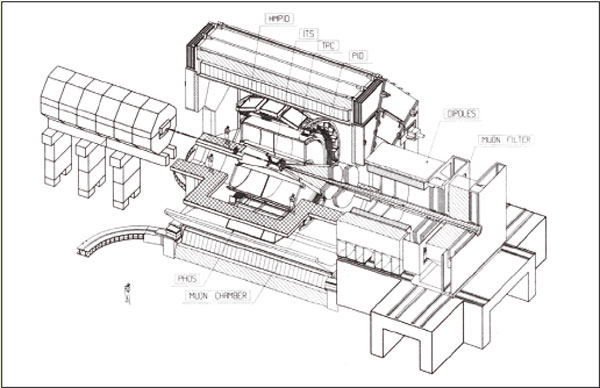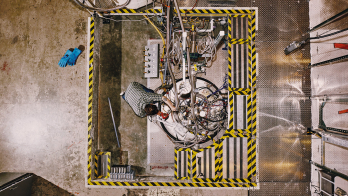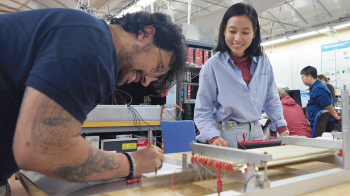
In the children’s story, Alice chased a white rabbit down a hole to find herself transported to a magical world. At the LHC, ALICE (A Large Ion Collider Experiment) will be pursuing new states of matter, and the wonderland to be found could be every bit as new and exciting. The LHC will continue CERN’s tradition of diverse beams, being able to accelerate not only protons, but also high-energy beams of lead ions. It is this capability which ALICE is designed to exploit.
The idea of building a dedicated heavy-ion detector for the LHC was first aired at the historic Evian meeting in March 1992. From the ideas presented there, the ALICE collaboration was formed, and in 1993, a Letter of Intent was submitted. High-energy heavy-ion collisions provide a unique laboratory for the study of strongly interacting particles. Quantum chromodynamics (QCD) predicts that at sufficiently high energy densities there will be a phase transition from conventional hadronic matter, where quarks are locked inside nuclear particles, to a plasma of deconfined quarks and gluons. The reverse of this transition is believed to have taken place when the universe was just 10–5 s old, and may still play a role today in the hearts of collapsing neutron stars.
The feasibility of this kind of research was clearly demonstrated at CERN and Brookhaven with lighter ions in the 1980s. Today’s programme at these laboratories has moved on to heavy ions, and is just reaching the energy threshold at which the phase transition is expected to occur. This physics reach will be extended at the RHIC heavy ion collider at Brookhaven, scheduled to come into operation in 1999. The LHC, with a centre-of-mass energy around 5.5 TeV/nucleon, will push the energy reach even further.
ALICE is bringing members of CERN’s existing heavy-ion community together with a number of groups new to the field drawn from both nuclear and high-energy physics. By LHC standards, the detector is of moderate proportions, being based on the current magnet of LEP’s L3 experiment. When LEP switches off, the L3 magnet will be left in place whilst ALICE is installed. LHC beams will pass through the magnet slightly off-centre, 30 cm higher than the current LEP beams.
On the trail of quark-gluon plasma
Because the physics of the quark-gluon plasma could be very different from that of ordinary matter, the ALICE detector has been designed to cover the full range of possible signatures, whilst being flexible enough to allow future upgrades guided by early results. The detector consists of two main parts, a central detector, embedded within the magnet, and a forward muon spectrometer included as an addendum to the Letter of Intent in 1995. The set-up is completed by zero-degree calorimeters located far downstream in the machine tunnel, to intercept particles emerging very close to the colliding beams.
One of the greatest challenges of heavy-ion physics is to pick out the individual tracks from the dense forest of emerging particles. ALICE’s tracking system has been designed for safe and robust pattern recognition within a large volume solenoid producing a weak field. The L3 magnet with a field of 0.2 tesla is ideal for the purpose.
The Inner Tracking System, lTS, consists of six cylindrical layers of highly accurate position-sensitive detectors from radii of 3.9 cm to 45 cm extending to ±45°. Its functions are secondary vertex recognition, particle identification, tracking, and improving the overall momentum resolution. The different layers are optimized for efficient pattern recognition. Because of the high particle density in the innermost regions, the first four layers provide position information in two dimensions. The first two layers are silicon pixel detectors, and the second two are silicon drift detectors. The two outermost layers will be composed of double sided silicon micro-strip detectors. The complexity and importance of this device is reflected in the number of institutions responsible for its production: Bari, Catania, CERN, Heidelberg, Kharkov, Kiev, Nantes, NIKHEF, Padua, Rez, Rome, St Petersburg, Salerno, Strasbourg, Turin, Trieste and Utrecht.
Central tracking is completed by a Time Projection Chamber, TPC, being built by Bratislava, CERN, Cracow, Darmstadt, Frankfurt, and Lund. Proven technology has been chosen to guarantee reliable performance at extremely high multiplicity. The drawbacks of this technology are high data volumes and relatively low speed. The TPC occupies the radial region from 90 cm to 250 cm, and is designed to give a rate-of-energy-loss resolution of better than 7%. It will also serve to identify electrons with momenta up to 2.5 GeV/c.
Identification parade
Two different technologies are under study for the last sub-detector to cover the full azimuthal angle, the particle identification system, PlD. Pestov spark counters, single-gap gas filled parallel-plate devices, are being investigated by Darmstadt, Dubna, Marburg, Moscow-ITEP, Moscow-MePHI, and Novosibirsk, whilst parallel plate chambers, PPCs, are being developed by CERN, Moscow-ITEP, Moscow-MePHI, and Novosibirsk. The final design is expected to be complete by the end of 1998. The PPCs are less demanding to construct and operate, but the Pestov counters give a timing resolution of less than 50 ps, some four times better than PPCs.
A second particle identification device for higher momentum particles, the HMPID, is included in the design as a single arm device above the central PlD. A ring-imaging Cerenkov (RICH) detector is the preferred option, being developed by Bari, CERN, Zagreb, and Moscow-INR. However, an organic scintillator approach being pursued by Catania, and Dubna has not yet been ruled out.
Below the central barrel region of the detector is another single-arm device, the photon spectrometer, PHOS, to measure prompt photons and neutral mesons. It is being prepared by Bergen, Heidelberg, Moscow-Kurchatov, Munster, Protvino, and Prague using scintillating lead tungstate crystals developed in the context of CERN’s generic detector R&D effort.
Zero-degree calorimeters, ZDC, will be positioned 92 m from the interaction point to measure the energy carried away by non-interacting beam nucleons, a quantity directly related to the collision geometry. These are calorimeters of the spaghetti type, with quartz fibres as the active medium. Their construction is the responsibility of Turin. Another forward detector, the forward multiplicity detector, FMD, will be embedded within the solenoid with the purpose of providing fast trigger signals and multiplicity information outside the central acceptance of the detector. Innovative micro-channel plate detectors are under consideration by Moscow-Kurchatov and St Petersburg, with conventional silicon multipad detectors as a back-up.
The forward muon spectrometer, FMS, is a major addition to the original design as specified in the Letter of Intent. It was included to measure the complete spectrum of heavy-quark resonances, which are expected to provide a sensitive signal for the production of a quark-gluon plasma. The first section of the spectrometer is an absorber placed inside the solenoid about 1 m from the interaction point. This is followed by a large 3 tesla dipole magnet outside the solenoid containing 10 planes of tracking stations. A second absorber and two further tracking planes provide muon identification and triggering. Teams from CERN, Clermont-Ferrand, Gatchina, Moscow-Kurchatov, Moscow-INR, Nantes, and Orsay are working on a more detailed design for the FMS, which is expected later this year.
Triggering is the responsibility of Birmingham and Kosice. Proton–proton mode and ion–ion mode have different trigger requirements. In proton–proton mode, a minimum bias trigger is required, whilst for ion–ion collisions, the trigger’s function is to select on collision centrality. A level zero trigger decision is made at around 1.2 microseconds based on centrality information from the FMD. At level-one (2 microseconds) this is supplemented by the ZDC. A dimuon trigger from the FMD also contributes to level-one. The final level-two trigger decision is made after further processing at 100 microseconds.
The architecture of the ALICE data acquisition system is determined by the relatively short heavy-ion runs foreseen for the LHC, roughly 10% of each year’s running. The collaboration will have ten times as long to analyse the data as they have to collect them, and so a high bandwidth system is envisaged in order to collect as much data as possible in the time available. CPU-intensive operations such as event filtering and reconstruction will be performed offline. Data acquisition is the responsibility of Budapest, CERN, and Oslo.
• March 1996 pp9–12 (abridged).
Green light for ALICE
ALICE has received the green light to proceed towards final design and construction. ALICE is the natural continuation, at CERN of the SPS Heavy Ion programme, initiated in 1986, which has recently provided exciting new results in the quest for the quark-gluon plasma.
Up to 50,000 charged particles are expected to be emitted in a lead–lead collision at the LHC of which about ten thousand will go through the ALICE central detector. That is why the central tracking in ALICE is based on the Time Projection Chamber (TPC) technique, which has already proven its value in registering tracks in a high multiplicity environment within the NA49 SPS experiment. The LHC collision rate in heavy ion mode is compatible with TPC drift times of around 100 microsec.
In the forward direction, within a 9 degree angle around the beam, ALICE will be equipped with a muon spectrometer, made of a sophisticated hadron absorber, a dipole magnet, five tracking stations (made of Cathode/pad Strip Chambers) and two trigger stations (made of Resistive Plate Chambers). Measurements on muon pairs are an essential part of the ALICE physics programme, since heavy dileptons probe the early stages of the produced medium.
• April 1997 pp4–5 (extract).








